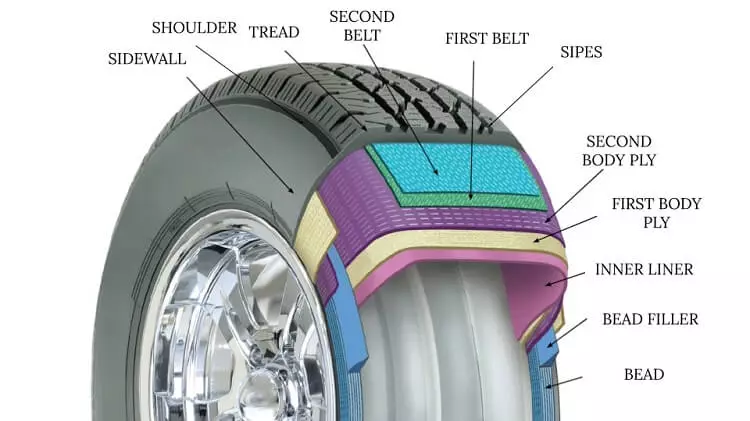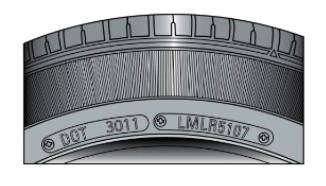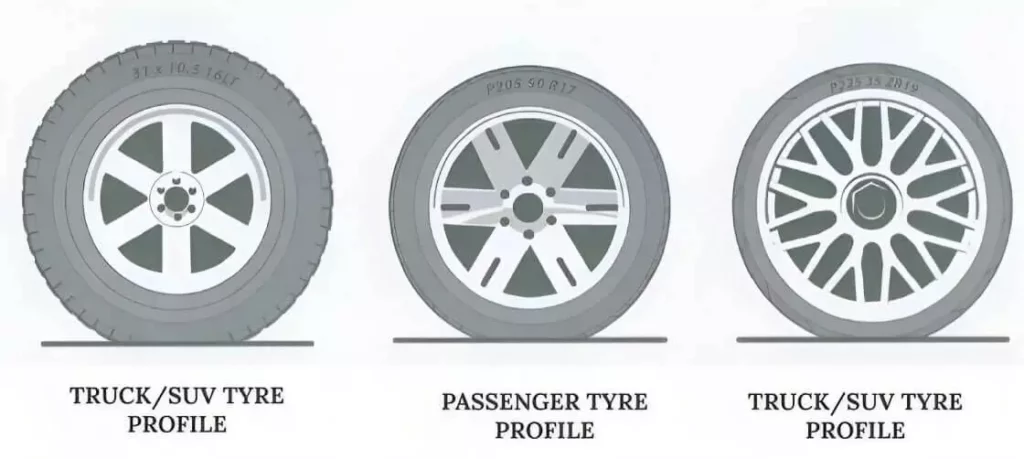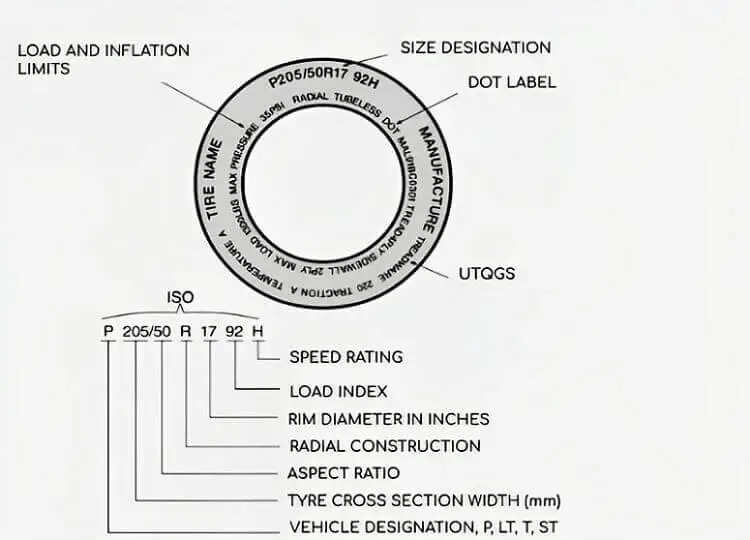Of the car’s major to minor parts we discussed in the previous article, namely 59+ Parts of car explained, the tyre is imperatively a key element that has multi-axial objectives to achieve: On one hand, it is responsible for giving a better ride at higher car accelerations, it plays a critical role when a driver applies brakes to either stop or decelerate the car on the other. Its other purposes include load bearing, shock absorption, safety, fuel consumption, and noise reduction, among many others.
So, What is a car tyre, actually?
Made of rubber, it is a critical car component that is fitted around the rim and provides necessary traction to the car by making direct contact with the road to move forward and backward.
According to each car’s specific set of requirements, the tyre design and size vary to give optimal rides with safety.
Different Parts of Tyre
Before one decides to buy a tyre for one’s car, there are certain parts of its structure whose names and functions one must know. Therefore, we enlist below the key elements of a car’s tyre, which are also called tyre’s anatomy.

Tread
It is the outermost part of a tyre that is in direct contact with the road surface and is used to provide traction to the car by providing necessary friction. It primarily consists of a pattern of grooves, channels, and sipes. With excessive use of cars, it is the tread of a tyre that affects the most and is therefore subject to maintenance from time to time in order to keep from inconvenience in the middle of a road.
Bead
It is the innermost part of a tyre that is in direct contact with the rim. It is made of high-strength steel wires that are entangled in a complex matrix, which in turn gives shape to the tyre as well.
Sidewall
It is the vertical section or a radial wall between the tread and bead of a tyre. It contains necessary information proper to tyre, such as its size, loading capacity, speed rating, and so on.
Sipes
These are small, narrow cuts or grooves in the tread block that provide special biting edges to the tyre for improved traction.
Carcass or Body Ply
To provide the necessary strength and resistance to deformation, the tyre is provided with layers of fabric cords that are coated with rubber. The fabric cords are made of polyester, nylon, or rayon.
Belts
In order to stabilize the area covered by the tread, typically, two or more steel belts are layered between the tread and the carcass. These belts help improve handling and provide needful puncture resistance.
Bead Filler
These are the special materials that are placed between the bead and the inner liner in order to provide more stability and structural formality to the tyre.
Shoulder
It is the area where the tread meets with the sidewall.
Tyre Sidewall Reinforcement
Some tyre manufacturers provide sidewalls with unique reinforcements in order to result in added strength and impact resistance to the tyre.
Tyre Valve Stem
Made of rubber or metal, it is a small tyre component that protrudes through the wheel and is responsible for the inflation and deflation of the tyre. It is given a valve cap that keeps the tyre from direct moisture.
Understanding of the Tyre Sidewall
- Tyre Width: It is the displacement (the shortest distance) between the left and the right sidewalls and is usually measured in millimeters.
- Tyre Aspect Ratio: It is the ratio of the tyre’s sidewall height to its width. In simple words, it shows the sidewall height in the percentage of the tyre’s width. Mathematically, it is expressed as below:
Aspect\;Ratio\;(A.R)\;=\;\frac{Sidewall\;Height}{Tyre's\;Width}\;\times\;100If the tyre has an aspect ratio of 60, it signifies that the sidewall height is 60% of the tyre’s width.
If a tyre’s sidewall is labeled as P215/65R15, it represents some necessary information related to its size, and it is described below:
- P shows that the tyre is for a passenger car. If it is LT, it shows a light truck tyre.
- 215 is the tyre’s width in mm.
- 65 is the aspect ratio (A.R).
- R means it’s a radial tyre type. B would be for bias ply, and D for the diagonal construction.
- 15 is the rim diameter.
Other necessary information available on the sidewall may include the following:
- Load Index: It is the maximum load that a tyre can carry when fully inflated. It is a two or three-digit number mentioned in the load index chart.
- Speed Rating: it shows the maximum speed of the tyre. It is usually denoted by letters such as H, V, W, Z.
- Brand and Model Number: Some tyre manufacturers reveal the brand name and model number of the tyre as well.
- DOT: It stands for Department of Transportation code that contains information such as related to the tyre’s manufacturing date, plant, tyre type, and so forth. The last four digits of the DOT code show the week and year of manufacturing.

Categorization of Tyre with Respect to Its Aspect Ratio
Based on their aspect ratio (sidewall height), tyres are usually classified as follows:

- Truck/SUV Tyre Profile: It is a tyre to carry heavy loads. It has a higher aspect ratio that helps it move over rough terrain and distribute the load evenly across its width. It also protects the rim from rock damage.
- Passenger Car Tyre Profile: It is a tyre to carry a passenger’s load. It has neither height nor a lower aspect ratio. It’s a trade-off between comfort and handling.
- Sports Car Tyre Profile: It has a lower aspect ratio, which is needed to keep the tyre from deflection while enhancing its cornering capability at elevated speeds. Its exterior design is exotic.
I am the author of Mechanical Mentor. Graduated in mechanical engineering from University of Engineering and Technology (UET), I currently hold a senior position in one of the largest manufacturers of home appliances in the country: Pak Elektron Limited (PEL).
